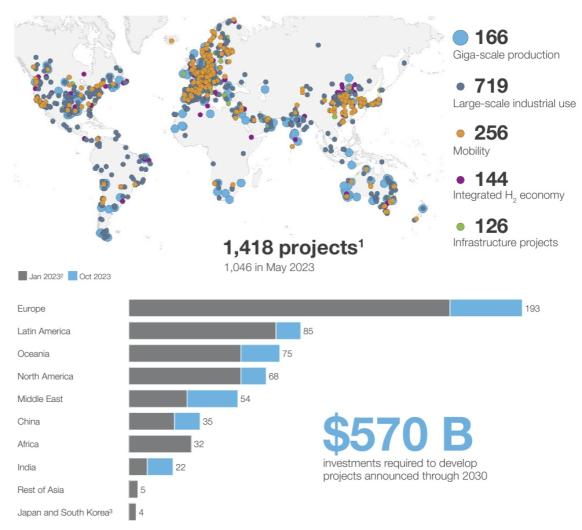COP hydrogen guidelines welcomed as a good start
Guidelines agreed upon at COP28 are seen as a good starting point for a globally harmonized approach to the production of clean hydrogen, but a failure to set carbon thresholds has some claiming ‘greenwashing’.

Related Articles
The 28th Conference of the Parties to the United Nations Convention on Climate Change in Dubai at the beginning of December was the latest, highly anticipated, multinational attempt to address global climate science and potential solutions.
For hydrogen, delegates penned a joint Declaration of Intent, signed by nearly 40 countries, and the International Organization of Standardization (ISO) launched a new methodology for assessing the greenhouse gas emissions of production.
“For the first time in the nearly 30-year history of COP, hydrogen was featured as part of the action agenda on the no-negotiated outcome side,” says Director of Policy and Partnership at the Hydrogen Council Daria Nochevnik.
The accords laid down at COP28 grant countries, investors, and consumers common methodologies, with system boundaries and allocation methods, to assess the carbon footprint of hydrogen production on a lifecycle analysis basis using global reference methodology.
“It's absolutely crucial to enable that transparency to allow us to compare different production pathways and ultimately allow the least carbon intensive one to shine,” says Nochevnik. “You’re able to compare apples with apples.”
It is essential that producing and consuming countries are on the same page to avoid market fragmentation and help create credible transparency, she says.
Joint Declarations
The Declaration of Intent agrees that the participants will work towards mutual recognition of respective certification schemes through accelerated development of technical solutions, taking into account the adoption of, or consistency with, globally recognized standards, and annual monitoring of progress.
While one country may say ‘clean hydrogen’, and another ‘low-carbon hydrogen’, the declaration strives to recognize that both are referring to hydrogen produced with renewable energy, nuclear energy, or carbon capture and storage, and therefore not inclusive of hydrogen produced with unabated fossil energy, including natural gas.
“The Declaration of Intent is acknowledging that we've got a little bit of a mishmash across different systems,” says Carolyn Kissane, founding director of the New York University SPS Energy, Climate Justice, and Sustainability Lab.
“When we're thinking about global trade of hydrogen, we're going to have to have some interoperability in place.”
The ISO standards, meanwhile, aim to define a methodology for determining the greenhouse gas emissions associated with the production of hydrogen from well to wheel.
“There are numerous pathways to produce hydrogen from various primary energy sources,” the ISO says in the introduction of the ISO/TS 19870:2023 standard.
The document describes the requirements and evaluation methods applied to several hydrogen production pathways of interest: electrolysis, steam methane reforming (with carbon capture and storage), co-production and coal gasification (with carbon capture and storage), auto-thermal reforming (with carbon capture and storage), auto-thermal reforming (with carbon capture and storage), hydrogen as a co-product in industrial applications, and hydrogen from biomass waste as feedstock.
The document also considers greenhouse gas emissions due to the conditioning or conversion of hydrogen into different physical forms and chemical carriers, such as hydrogen liquefaction, production, transport, and cracking of ammonia as a hydrogen carrier, hydrogenation, and dehydrogenation of liquid organic hydrogen carriers (LOHCs).
Not included
What the declaration and the ISO documents do not include is specific targets for how much CO2 can be released in the production of the hydrogen for it to be defined as ‘clean’.
It is this last step that has some claiming the agreements amount to ‘greenwashing’.
By failing to include an emissions threshold for clean hydrogen, say critics, the ISO process is leaving the door open to inefficient practices, including those that rely on traditional hydrogen production using fossil fuels combined with carbon capture and storage (CCS).
Recent studies suggest that CCS should be avoided when for the production of clean hydrogen amid concerns that vast resources will be poured into practices that have an unproven track record and could be as polluting as the fossil fuels the world is attempting to move away from.
“The hydrogen economy is evolving quickly, and so is the science that informs our understanding of its impacts – both positive and negative,” says Steven Hamburg, Senior Vice President and Chief Scientist, at the Environmental Defense Fund.
“As the industry moves into deployment and scale up, it is absolutely crucial that international standards are keeping up with the latest science. Failing this, our efforts to reduce climate pollution could easily go off track.”
Pending Global Hydrogen Projects
(Click to enlarge)
Source: Hydrogen Council and McKinsey & Company 'Hydrogen Insights 2023'
Better on board
The argument against CCS and fossil-fuel-derived hydrogen, whether proven to be valid or not, is sometimes framed as an attempt to sideline oil and gas companies who are entering the clean hydrogen industry.
However, demonizing oil companies and fossil-fuel producing states ignores their integral role in the global energy mix, NYU’s Kissane said in an opinion article ‘Oil Companies Can’t be Wished out of the Climate Conversation.’
World oil demand will continue to rise throughout this decade and the next, according to the International Energy Agency and, while calls for sharp declines in fossil fuels persist, “there’s a dissonance in the rhetoric and the reality,” Kissane writes.
“We have to reckon with the reality in which we live. The transition is going to be a long one and we know it's going to be expensive,” she says.
“Better to have them on board and put their money, infrastructure, and expertise to work. Why exclude them when they're going to be a part of a portfolio of solutions? Better to bring them on board and to put the pressure on them.”
By Paul Day

